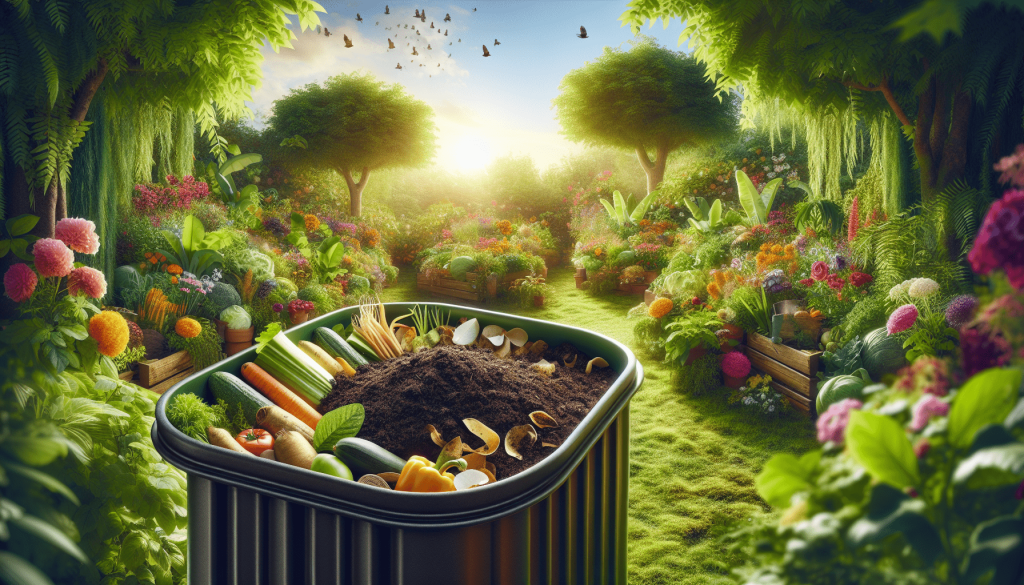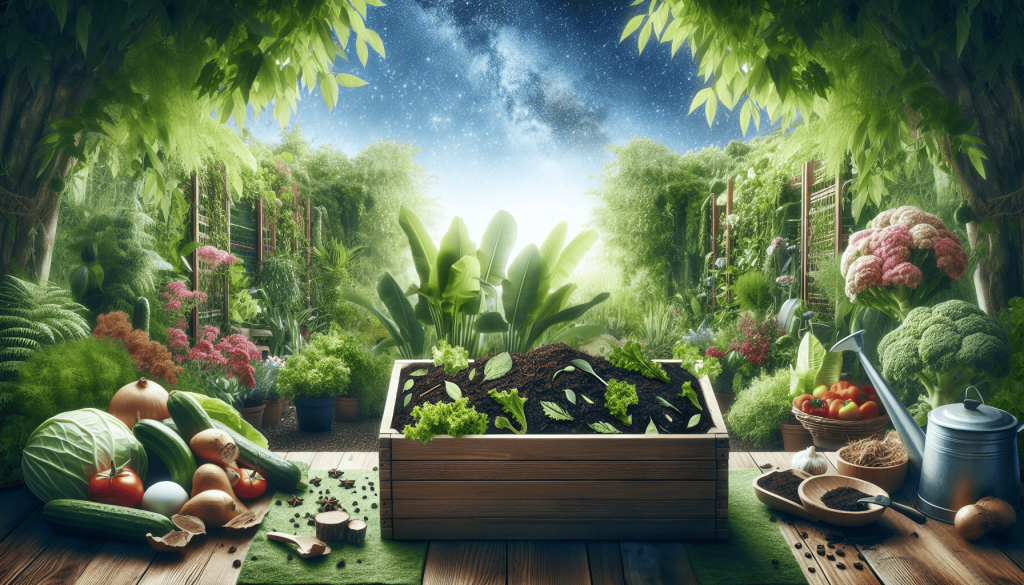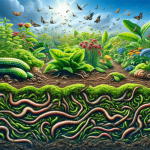This post may contain affiliate links. As an Amazon Associate, we may earn commissions from qualifying purchases.
Have you ever wondered how your gardening habits might be contributing to waste? You might be surprised at how many standard gardening practices result in excess waste that could otherwise be avoided. Not only is this waste harmful to the environment, but it’s also resource-intensive and costly in the long run.

What is Sustainable Gardening?
Sustainable gardening is an approach that focuses on maintaining the health of your garden as well as the surrounding environment. It seeks to minimize resources, reduce waste, and support local ecosystems. By adopting sustainable practices, you can create a thriving garden that complements nature rather than competes with it.
The Importance of Sustainable Gardening
Choosing sustainable gardening practices is crucial for several reasons. Firstly, it helps reduce the carbon footprint by limiting the use of synthetic materials and chemicals. Secondly, it promotes biodiversity by creating a habitat for various plant and animal species. Finally, it conserves natural resources such as water and soil, ensuring that future generations can also enjoy gardening.
Practices for Reducing Waste in Your Garden
Now, let’s explore some practical and sustainable gardening practices that will help you reduce waste.
Composting for Soil Health
Composting is one of the most effective ways to reduce waste in the garden. It involves the breakdown of organic matter, such as vegetable scraps and yard waste, into nutrient-rich compost that can be used to improve soil health.
Benefits of Composting
- Improves Soil Structure: Compost can improve the soil’s structure, making it easier for roots to grow.
- Retains Moisture: Helps retain moisture, reducing the need for frequent watering.
- Reduces Waste: Diverts organic waste from landfills.
How to Compost
- Choose a spot: Select a shady spot in your garden for your compost bin or pile.
- Layering: Start with a layer of coarse materials like twigs and branches, followed by layers of green (nitrogen-rich) and brown (carbon-rich) materials.
- Maintenance: Turn the compost regularly to aerate it and speed up the decomposition process.
Here’s a simple table for what you can and can’t compost:
| Green Material (Nitrogen) | Brown Material (Carbon) | Materials to Avoid |
|---|---|---|
| Fruit scraps | Dead leaves | Meat or dairy products |
| Vegetable scraps | Straw | Diseased plants |
| Coffee grounds | Paper (non-glossy) | Weeds gone to seed |
| Grass clippings | Cardboard | Pet waste |
Rainwater Harvesting
Water is a precious resource, and rainwater harvesting is an excellent way to make the most of this essential natural element. Harvesting rainwater involves collecting and storing rainwater for later use.
Benefits of Rainwater Harvesting
- Reduces Water Bills: Less reliance on tap water can significantly lower your water bill.
- Environmentally Friendly: Reduces the demand on local water resources.
- Improves Plant Health: Rainwater is free of chemicals like chlorine and fluoride, which are often present in municipal water.
How to Harvest Rainwater
- Install a Rain Barrel: Place a rain barrel under a downspout to collect rainwater from your roof.
- Filter the Water: Use a fine mesh screen to filter out debris.
- Connect a Hose: Attach a garden hose to the rain barrel spigot to direct the water where it’s needed.
Mulching to Conserve Resources
Mulching is the practice of covering the soil surface with materials such as wood chips, straw, or compost to retain moisture, suppress weeds, and improve soil health.
Benefits of Mulching
- Moisture Retention: Keeps the soil moist, reducing the need for frequent watering.
- Weed Control: Suppresses weed growth, reducing the need for herbicides.
- Soil Health: Adds organic matter to the soil as it breaks down.
Types of Mulch
- Organic Mulch: Includes materials like wood chips, straw, and leaves. It breaks down over time, enriching the soil.
- Inorganic Mulch: Includes materials like gravel and plastic sheeting. It is long-lasting but does not improve soil health.
Using Native Plants
Native plants are those that naturally occur in your local area. They are adapted to the local climate and soil conditions, making them an excellent choice for sustainable gardening.
Benefits of Using Native Plants
- Low Maintenance: Require less water, fertilizer, and pest control.
- Supports Local Wildlife: Provides habitat and food sources for local birds, insects, and other wildlife.
- Resilient: More resistant to local pests and diseases.
How to Choose Native Plants
- Research: Look up your local extension service or native plant society for information.
- Local Nursery: Visit a local nursery that specializes in native plants.
- Observation: Notice what plants are thriving in your neighborhood.
Planting a Vegetable Garden
Growing your own food is a rewarding way to practice sustainable gardening. A vegetable garden can reduce your carbon footprint by cutting down on the distance food travels to reach your plate.
Benefits of a Vegetable Garden
- Fresh Produce: Enjoy fresh, organic vegetables right from your backyard.
- Reduces Waste: Less packaging and food waste compared to store-bought produce.
- Educational: Learn about plant growth, seasons, and ecosystems.
Tips for Starting a Vegetable Garden
- Select a Site: Choose a sunny spot with well-drained soil.
- Plan Your Garden: Decide what vegetables you want to grow and create a planting plan.
- Prepare the Soil: Enrich the soil with compost and other organic matter.
- Plant and Maintain: Follow planting instructions and provide regular care.
Integrated Pest Management (IPM)
Integrated Pest Management (IPM) is a sustainable approach to controlling garden pests. It combines biological, cultural, physical, and chemical tools to manage pests in a way that minimizes risks to people and the environment.
Benefits of IPM
- Reduces Chemical Use: Minimizes the need for chemical pesticides.
- Eco-Friendly: Protects beneficial insects and reduces environmental impact.
- Effective: Generally more effective in the long term compared to relying solely on chemical controls.
IPM Techniques
- Biological Control: Uses natural predators or parasites to control pests.
- Cultural Control: Implements practices like crop rotation and plant spacing to reduce pest problems.
- Physical Control: Involves mechanical methods like traps or barriers.
- Chemical Control: Uses pesticides as a last resort, applying the least toxic options available.
Utilizing Recycled And Recyclable Materials
When it comes to gardening supplies, consider using recycled or recyclable materials to further reduce waste. This can include everything from plant pots to garden structures.
Benefits of Using Recycled Materials
- Reduces Landfill Waste: Keeps materials out of landfills.
- Cost-Effective: Often cheaper than buying new materials.
- Resource Efficiency: Conserves natural resources by reusing existing materials.
Examples of Recycled Materials in Gardening
- Plant Pots: Use containers made from recycled plastic or other recycled materials.
- Garden Beds: Build raised beds from reclaimed wood or composite materials.
- Pathways: Create garden paths using recycled bricks, stones, or wood chips.
Practicing Seed Saving
Seed saving is the practice of collecting and storing seeds from your own plants to use in future seasons. This practice not only saves money but also helps preserve heirloom plant varieties and promotes biodiversity.
Benefits of Seed Saving
- Cost Savings: Reduces the need to buy new seeds each year.
- Biodiversity: Supports the preservation of diverse plant varieties.
- Adaptation: Allows plants to adapt to your local growing conditions over time.
How to Save Seeds
- Select Healthy Plants: Choose plants that are healthy and have desirable traits.
- Collect Seeds: Gather seeds when they are fully mature.
- Dry Seeds: Make sure seeds are completely dry before storing.
- Store Seeds: Keep seeds in a cool, dry place in properly labeled containers.
Building and Using a Worm Bin
Worm bins, also known as vermicomposting bins, are a fantastic way to recycle kitchen scraps and create a rich, nutrient-dense compost for your garden.
Benefits of Vermicomposting
- Reduces Waste: Kitchen scraps are transformed into valuable compost.
- Nutrient-Rich: Produces worm castings that are incredibly beneficial for soil health.
- Compact: Suitable for those with limited space.
How to Set Up a Worm Bin
- Choose a Container: Any container with proper ventilation and drainage will work.
- Bedding: Fill the bin with bedding material such as shredded newspaper or coconut coir.
- Add Worms: Introduce red wigglers (Eisenia fetida) to the bin.
- Feed the Worms: Add kitchen scraps and keep the bin moist but not waterlogged.
Reducing Lawn Size
Lawns are often high-maintenance and resource-intensive. Reducing the size of your lawn can significantly decrease water usage and lower your garden’s environmental impact.
Benefits of Reducing Lawn Size
- Conserves Water: Less lawn to water means reduced water usage.
- Supports Biodiversity: Allows for more diverse planting options which can support wildlife.
- Lower Maintenance: Less mowing, fertilizing, and pest control needed.
Alternatives to Lawns
- Ground Covers: Use low-growing plants that require less water and maintenance.
- Flower Beds: Create colorful beds of native flowers and shrubs.
- Food Gardens: Convert lawn space into areas for growing vegetables and herbs.
Implementing These Practices
To get started, consider choosing a few of the practices mentioned above and gradually incorporating them into your gardening routine. Sustainable gardening doesn’t have to be overwhelming; small changes can make a significant impact over time.
Tips for Starting with Sustainable Gardening
- Set Realistic Goals: Start with achievable goals and gradually expand your efforts.
- Educate Yourself: Take the time to learn about sustainable practices and their benefits.
- Experiment: Don’t be afraid to try new methods and see what works best in your garden.
- Share Your Knowledge: Encourage friends and neighbors to adopt sustainable gardening practices.
Conclusion
Sustainable gardening is not only beneficial for the environment but also for your garden’s long-term health. By adopting practices such as composting, rainwater harvesting, mulching, and using native plants, you can create a thriving garden ecosystem that minimizes waste. Sustainable gardening is a journey, and every small step you take contributes to a healthier planet.
Remember, sustainable gardening is all about working with nature, not against it. So go ahead, put these practices into action, and enjoy the many benefits of a waste-free, eco-friendly garden. Your effort will not only yield a beautiful garden but also make a positive impact on the environment.









